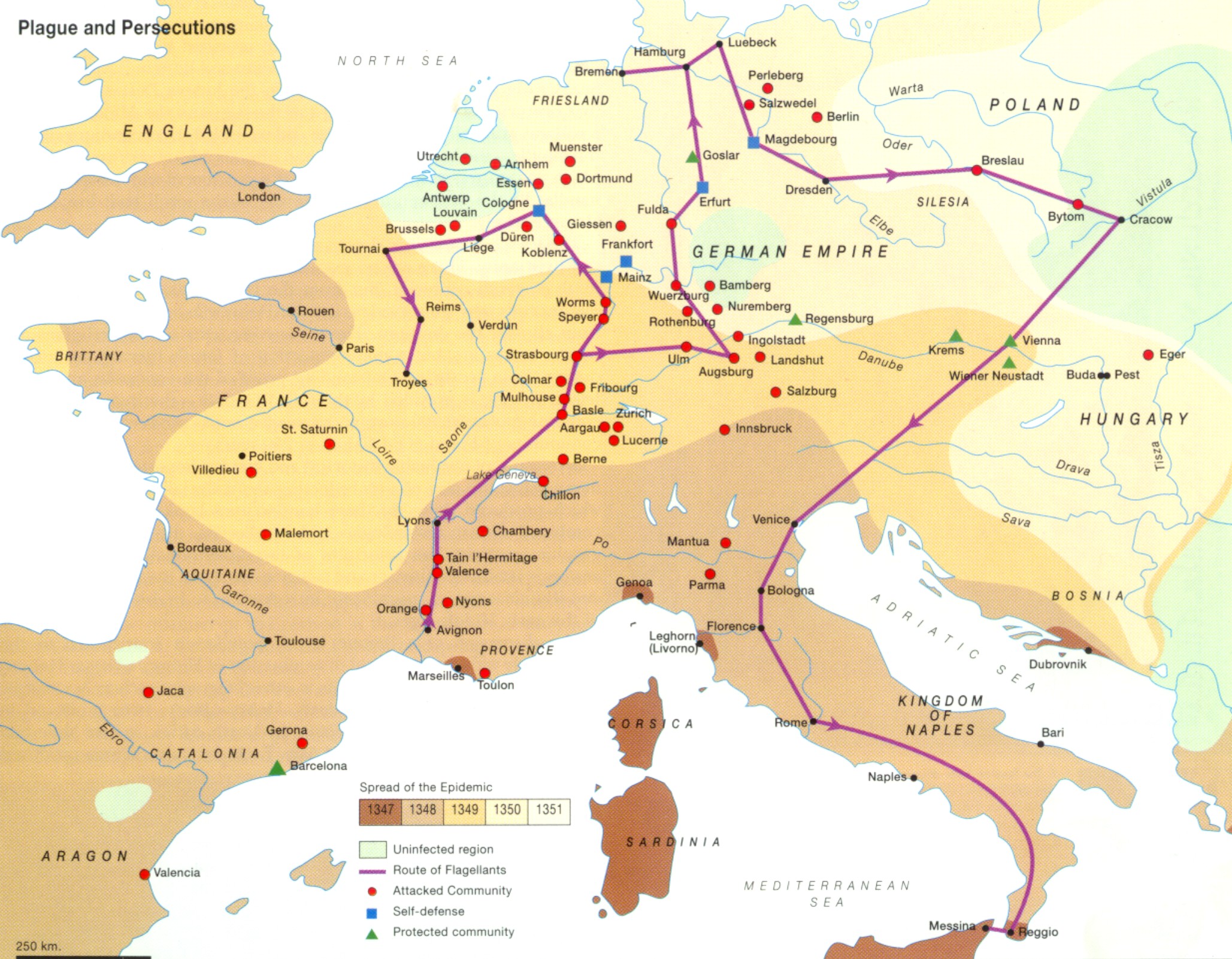Late Medieval Persecutions

Plague and Persecution
Common accusations against the Jews in the late medieval period included the blood libel (and the closely related charge of ritual murder), and the charge of desecrating the host.
The first case of ritual murder was that of the boy William of Norwich, who disappeared in 1144. A contemporary Christian chronicler relates that the Jews of Norwich bought a Christian child before Easter and tortured him "with all the tortures wherewith our Lord was tortured," crucified and buried him. There was no evidence that a murder had been committed, as the mother and uncle of the child claimed. Yet a religious cult grew up around the tomb of the child.
This became the “prototype” of the ritual murder charge, which was often made around the Easter holiday. The idea that Jews killed the child to obtain its blood for Jewish magical purposes (or for the Jewish Passover, which falls near Easter) also became common.
One of best known cases of the ritual murder charge was that of Simon of Trent, about which you will read in R. Po-chia Hsia, Trent 1475. For more general information, see
blood libel.

Ritual Murder of Sappenfeld

15th century German depiction of Jews comitting ritual murder and bestiality, and associating with the devil.
Question: How can you explain the power of such fantasies in the Christian imagination?
Another common charge against the Jews was the desecration of the host. The doctrine of
transubstantiation was established at the Fourth Lateran Council in 1215, and the host, in effect, became an object of worship. This seems to have prompted a variety of accusations about Jews desecrating the object (the assumption being that Jews accepted the divine attributes of the host). A typical plot was this: A Jew bribes a Christian to secure a wafer of the host; the Jew then mutilates the host - beats it, stamps it, pierces it with a knife, etc. - whereupon blood flows from the wafer and something miraculous occurs: the Jew is paralyzed, or the wafer flies out of his grasp, etc.
In medieval representations of host desecration, depicted in paintings, chronicles, and plays, the eucharist became interchangeable with the Christ Child. The danger of these charges no doubt increased with the establishment in 1264 of the feast of Corpus Christi as a means to arouse enthusiasm for the doctrine of transubstantiation, as well as hostility to those who doubted it. Like other charges, the host desecration charges usually implicated the entire Jewish community. Sometimes the desecration was said to take place in a synagogue, as part of Jewish ritual. The first accusation of host desecration took place in 1243 at Belitz, near Berlin. All the Jews of the city were burned on the spot, subsequently called the
Judenberg.

Sternberg Jews stabbing the Host, Germany, 1492

Jews Mocking the Host in Pressburg, 1591
The most uninhibited anti-Jewish image of the medieval period was that of the
Judensau (Jewish sow). Its popularity is certainly related to its obscenity.
Judensau images – images of Jews sucking the teats of a sow - occur in German architectural sculpture from the thirteenth to the sixteenth centuries, mostly in churches. The motif later adopted other obscene aspects: the sow is embraced, fondled, and kissed; there is preoccupation with the sow's hindquarters; its excrement is eaten and drunk; the Jews are depicted as the offspring of the sow.

The 'Judensau' - woodcut of c. 1470.
The persecution of the Jews reached a peak during the Black Death, in 1348-9. The bubonic plague hit Europe in these years on an unprecedented scale. In many places more than half the population died in a short period of time. Without a rational explanation, people found an explanation in the available sinister presence of the Jews. The Jews were accused of poisoning the wells to cause the plague, with the aim of destroying all of Christendom. News of the Jews’ guilt spread so quickly that in some places Jews were killed before the plague arrived. In 1348, Pope Clement VI spoke out against “the infamy that certain Christians have been incited by the Devil to find as the cause for the plague…in acts of poisoning on the part of the Jews.” The pope declared the accusations false “in light of the fact that this plague has struck different parts of the world, both amid the Jews themselves and also among other nations where Jews do not dwell at all.” But this had little effect on the masses.
Back





